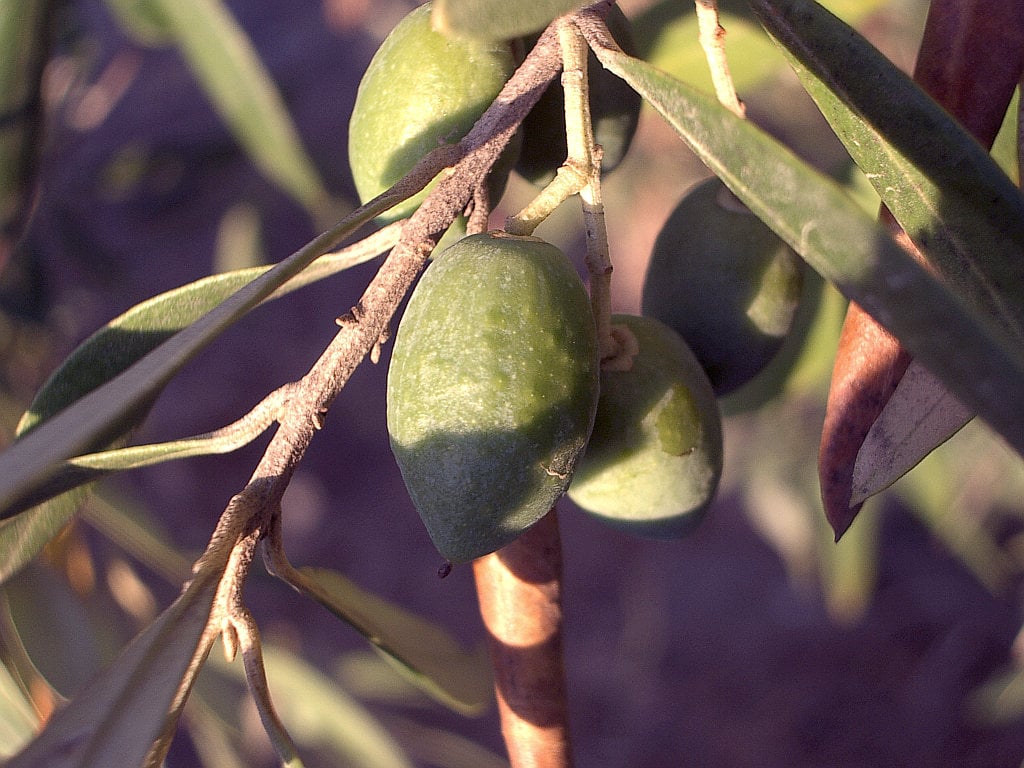
Olive oil is one of Greece’s most historically and culturally significant exports. Thousands acres of farmland full of olive trees dot the country. Throughout the seasons, olive trees change as the fruit ripens.
By Lisa Radinovsky
In olive oil producing countries such as Greece, tourists can wander through olive groves all year, observing not only the summer growth of olives, but their autumn harvest, the winter landscapes, and the the new spring branches, leaves, and blossoms as well.
The cycle’s annual repetition in the form of the seasons is as timeless as the earth. People and nature work together to make “Greek liquid gold” from the ultimate living symbol of Greece, the olive tree.
Through the summer and as fall begins, I watch the olives around me grow under the hot sun, then gaze at their silhouettes against the sunset.
Drawn to the welcome shade of their trees, I revisit the same trees often, considering the sizes and shapes of different olive varieties and some olives’ faster growth than others.
As I do this, I am breathing in the heavenly scent of wild sun-dried herbs nearby.
Olives are ready for harvest in autumn
Autumn rains reveal shades of purple and lavender, black and maroon, as some olives are washed clean, dark, and shiny, while others retain a paler hue.
After a storm, I admire tiny raindrops resting on purple olives, lightly glistening under the cloudy sky.
I observe drops hanging from shiny wet green leaves and briefly clinging to a wine-red olive, the drop reflecting the soft light before it falls.
As the weather cools, I notice signs of the olive harvest around me. Especially in November, I see the pickup trucks of the part-time olive farmers parked on the roadsides and in the olive groves, awaiting their cargo of olives.
Giant green nets are spread beneath the olive trees, and people of all ages beat the branches with harvesting instruments that resemble rakes or pitchforks until the olives fall onto the nets.
Professional olive farmers hire teams of laborers to help them, but for many Greeks, the annual harvest is a traditional family affair, with the oil distributed among friends and family members.
I sometimes drive west of Chania on the national highway to the endless groves of silvery green leaves and olives in the rolling hills of the Kolymbari area, where I first fell in love with the Greek olive landscape.
Heading inland off the highway into a prime example of Cretan olive country one Autumn day, I pass warehouse-like village olive mills with pickup trucks and burlap bags full of olives.
I find a couple harvesting green olives on a steep hillside as their young son plays nearby.
Wildflowers bloom throughout the groves
In the winter, after the harvest, I treasure the graceful lines of olive leaves silhouetted against the brilliant blue or the ornamental clouds of the infinite sky.
I survey the landscape covered with olive trees that run down to the sea, fill a valley, and climb a hillside, often with spectacular cloud compositions of puffy white billows rising behind them.
Even Crete has some miserable winter days of clouds, wind, and cold rain, but of course the olive trees welcome the rain.
In the mountains, and on rare occasions closer to sea level, they even welcome the snow.
At lower elevations, snow may lightly coat olive branches in white to complement their evergreen leaves and dark wet trunks, spreading patterns of white carpet next to the green of sorrel leaves protected by the trees’ canopies.
On such days, I am mesmerized by the olive leaves and branches outlined in icy snow and then coated in ragged layers of gray-white, with tiny icicles forming at their tips.
After the fall and winter rains (and sometimes snow) on Crete, wildflowers begin to bloom in some olive groves, especially in the open spaces between younger trees. As neighbors gather wild greens to eat, I follow the emergence of new types of blossoms and photograph them beneath the olive trees.
Crocuses and anemones appear by January, wood sorrel and orchids come for a colorful February, serapias, daisies, and field gladiolas bring in a brilliant March, and tassel hyacinth dresses up April.
Here in the Chania area, wildflowers bloom throughout the winter, beginning to fade in the heat of the sun by May Day.
You can visit olive groves in any season
As other flowers fade, I turn to the olive trees, where the delicate clusters of tiny yellow-white blossoms that began appearing in winter are flourishing by April.
With my camera, I attempt to capture their elusive beauty and the sense that these flowers create their own fairyland.
Olive flower pollen dusts my hat and hands. The olive fruit begins to form even before all the flowers have dried up in the warm sun and dropped from the tree.
Then it’s time to begin watching the baby olives, which start out the size of a grape seed. I monitor their growth as the months pass.
One day in May, I head toward Kolymbari, then turn inland onto a small road, passing through quiet villages with thousands of olive trees between, around, and beyond them.
The olive branches full of tiny flowers wave wildly in the strong island wind as swallows suddenly swoop out from between the olive trees, darting over and above the road, the trees, and my car.
Clouds and rain create a dramatic darkened backdrop for village flower gardens which display astonishing bright reds, pinks, greens, and whites, while tall, dark, pointed evergreens contrast with the light yellow-green of new spring leaves on deciduous trees and the silvery green of the dancing olive leaves.
It is always time to visit the olive groves of Greece.
This article contributed by Lisa Radinovsky from Greek Liquid Gold



Comments
Post a Comment